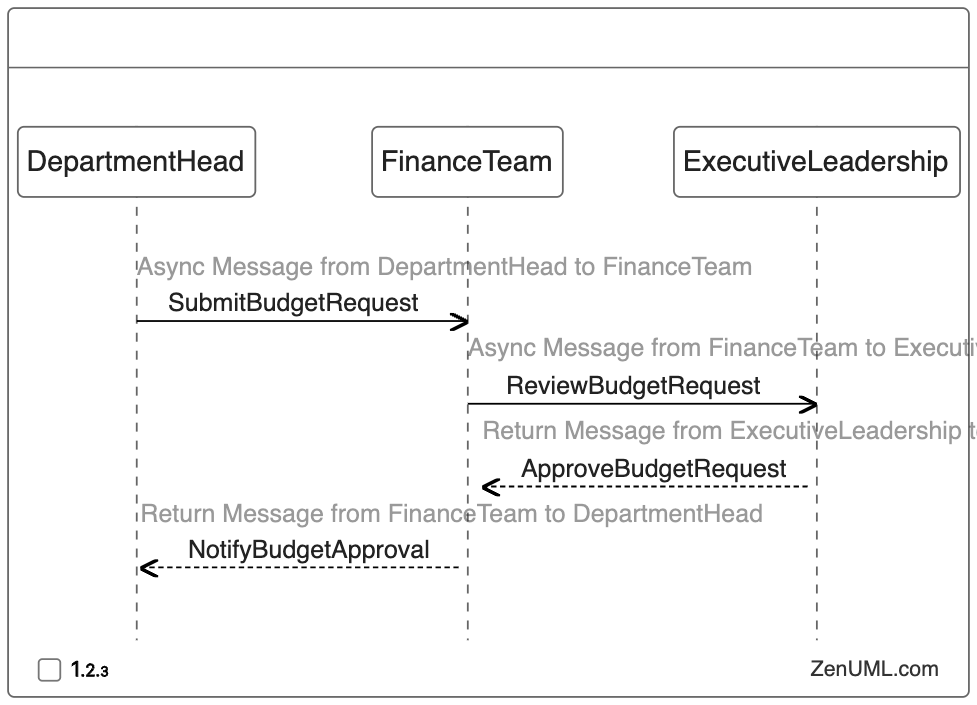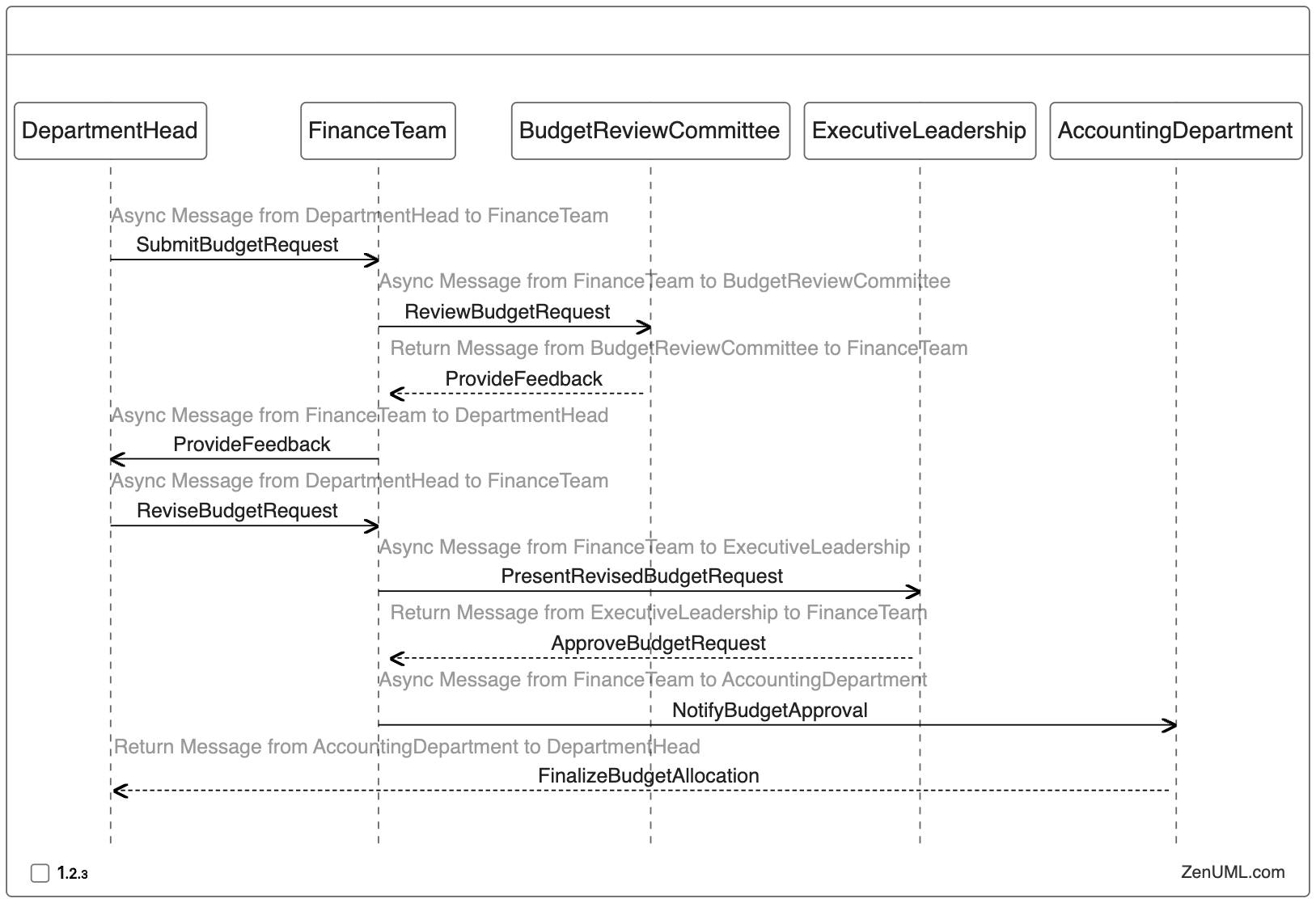Introduction
In the dynamic world of business, efficient management of resources is crucial for success. One critical aspect of this is the budget approval process, which can often be complex and time-consuming. However, by leveraging the power of sequence diagrams, businesses can streamline this process, improve transparency, and enhance decision-making.
This blog post will explore the role of sequence diagrams in business process modeling, specifically in the context of budget approval. We'll delve into the benefits of using sequence diagrams, provide practical examples, and discuss how they can be implemented to optimize the budget approval workflow.
Sequence Diagrams: The Backbone of Business Process Modeling
Sequence diagrams are a powerful tool in the realm of business process modeling. These visual representations depict the interactions between different entities or actors within a system, showcasing the flow of information and the order in which events occur. When it comes to the budget approval process, sequence diagrams can provide valuable insights and enhance the overall efficiency of the workflow.
Defining the Budget Approval Process
The budget approval process typically involves multiple stakeholders, including department heads, finance teams, and executive decision-makers. This process ensures that the allocation of financial resources aligns with the organization's strategic objectives and budgetary constraints. However, without a clear understanding of the underlying workflow, the approval process can become convoluted, leading to delays, miscommunications, and potential conflicts.
Leveraging Sequence Diagrams for Budget Approval
By utilizing sequence diagrams, businesses can map out the step-by-step interactions and information flow involved in the budget approval process. These diagrams help to:
-
Visualize the Approval Workflow: Sequence diagrams provide a clear and concise visual representation of the budget approval process, allowing stakeholders to understand the sequence of events, the roles and responsibilities of each party, and the decision-making points.
-
Identify Bottlenecks and Inefficiencies: By analyzing the sequence diagram, businesses can pinpoint areas where the approval process may be prone to delays, redundancies, or bottlenecks. This information can be used to streamline the workflow and optimize the overall efficiency.
-
Enhance Communication and Collaboration: Sequence diagrams serve as a shared language, facilitating effective communication and collaboration among cross-functional teams involved in the budget approval process. This promotes transparency and reduces the potential for misunderstandings.
-
Facilitate Training and Onboarding: Sequence diagrams can be used as a training tool, helping new team members or stakeholders understand the budget approval process and their respective roles within it.
-
Support Decision-Making: The insights gained from sequence diagrams can inform strategic decision-making, enabling businesses to make more informed choices about budget allocation, resource prioritization, and process optimization.
Practical Examples: Sequence Diagrams in Action
Let's dive into some practical examples of how sequence diagrams can be applied to the budget approval process.
Example 1: Basic Budget Approval Workflow
Consider a simple budget approval workflow where a department head submits a budget request, which is then reviewed and approved by a finance team and the executive leadership.

In this example, the sequence diagram clearly outlines the step-by-step interactions, the roles of each stakeholder, and the flow of information throughout the approval process.
Example 2: Complex Budget Approval Workflow
Now, let's consider a more complex budget approval workflow that involves multiple layers of review and approval.

In this more intricate example, the sequence diagram captures the iterative nature of the budget approval process, including the feedback loop between the department head, finance team, and budget review committee. It also demonstrates the involvement of the executive leadership and the accounting department, providing a comprehensive view of the entire workflow.
Business Analysis and Sequence Diagrams
Sequence diagrams are not only valuable in the context of budget approval but also play a crucial role in the broader realm of business analysis.
Identifying Pain Points and Opportunities
By analyzing the sequence diagrams, business analysts can uncover pain points, bottlenecks, and inefficiencies within the budget approval process. This information can then be used to identify opportunities for process optimization, leading to improved resource allocation, reduced turnaround times, and enhanced decision-making.
Aligning Processes with Business Objectives
Sequence diagrams can help business analysts ensure that the budget approval process aligns with the organization's overall strategic objectives. By visualizing the workflow, analysts can identify areas where the process may be misaligned or where changes can be made to better support the organization's goals.
Facilitating Stakeholder Engagement
Sequence diagrams serve as a powerful communication tool, enabling business analysts to engage with various stakeholders involved in the budget approval process. By presenting the diagrams, analysts can foster a shared understanding, gather feedback, and collaborate with stakeholders to refine the process.
Continuous Process Improvement
Sequence diagrams can be used to monitor and evaluate the budget approval process over time. By tracking changes in the workflow and analyzing the impact of process improvements, business analysts can drive continuous optimization and ensure the ongoing efficiency of the budget approval process.
Conclusion: Unlocking the Power of Sequence Diagrams
In the dynamic world of business, the effective management of resources is crucial for success. By leveraging the power of sequence diagrams, businesses can streamline the budget approval process, enhance transparency, and support strategic decision-making.
Through the practical examples and insights provided in this blog post, you've seen how sequence diagrams can be used to visualize the budget approval workflow, identify pain points, and optimize the overall process. By embracing this powerful tool, businesses can unlock new levels of efficiency, collaboration, and alignment with their strategic objectives.
We invite you to share your experiences and insights in the comments section below. How have you utilized sequence diagrams in your own business processes? What challenges have you faced, and how have you overcome them? Your feedback and contributions can help us continue to explore the transformative potential of sequence diagrams in business process modeling.
Try ZenUML now!
Zenuml detailed feature roadmap available here.

